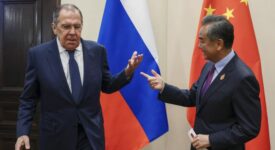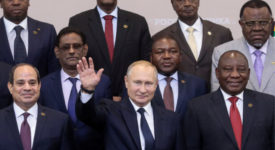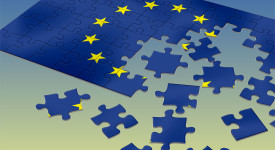The year 2013 marked a return of investor confidence in euro area financial markets. Capital inflows to the euro area and a sharp reduction of yield on sovereign debts in peripheral countries, and the extended use of the single currency in central, eastern and south-eastern Europe (CESEE), have added a certain optimism that the worse is over for the single currency. Yet, in the international arena, things are going less well – at least from the euro-zone’s perspective. The euro’s share in global foreign exchange reserves decreased by around one percentage point in 2013.
Allocations for the 52 percent of international currency reserves for a value of US $11.9 trillion disclosed to the IMF allocate 61 percent share of holdings to U.S. dollar. The yen and pound each have about a 4 percent share. The Australian and Canadian dollars both represent less than 2 percent of global holdings, while the euro’s share stands at about 24.5 percent, down from a record 28 percent in 2009. In a Central Banking publication released on June 23, the single currency lost in just one year about one percent from a year earlier, according to the data provided by 62 percent of world’s central banks that took part in the private survey.
Though continuing to occupy the second position after the U.S. dollar in foreign exchanges reserves portfolios, fresh data suggest that foreign exchange managers have started ‘replacing’ the euro by new entries, such as the Canadian and Australian dollars. With the big chunk of unallocated foreign reserves currently standing at around US$10 trillion, these data seem clearly detecting an increase of risk perception among foreign reserves managers, and a proactive attitude to diversification policies, which seem most likely to hit especially the euro. Market analysts have been pointing to the euro-zone crisis and ongoing impasses as the most likely explanation for this trend. The area is still struggling with too much debt, and too little growth. To make matters worse, geopolitical tensions between Russia and the West over Ukraine and other former Soviet satellites, and the situation in Iraq, are due to affect mostly European economies. Energy supply-shocks and the expected rising energy prices would dry out households’ real disposable incomes and corporate profitability, with negative implications for the area’s GDP growth.
In particular, political pressures prompted by the European election earlier in May for more flexible fiscal rules and more fiscal deficit will render it more difficult for the ECB to buy government bonds from some large Member States who may be relying on this ‘tool’ to fund their ballooning budget deficits. As a matter of fact, the primary purpose of foreign exchange reserves is not to make a profit, but rather to protect the national currency against exchange rate fluctuations. However, the European Central Bank’s unprecedented stimulus measures, which aimed at trimming down the euro’s exchange rate to boost euro-area export performance and increase the area’s inflation towards the 2 percent target, are clearly set to backfire on the euro’s value, and also relatively to its position as a No. 2 foreign exchange reserve currency.
ECB’s drastic interest-rate cuts, the charges imposed on overnight deposits and liquidity programs implemented since early June to avoid deflation have made the 18-nation euro less attractive. Banks from JPMorgan Chase & Co. to Societè Generale SA predict that it will lose out to currencies such as South Korea’s won and the Australian dollar, favored for the higher yields paid by their bonds. “Reserve managers are moving out of Europe into Asia,” Sebastien Galy, a senior currency strategist at Societè Generale in New York said in a July 3 phone interview with Bloomberg. With unimpressive economic data and inflation continuing to fall, investors still expect more liquidity via purchases of asset-backed securities (ABS) and quantitative easing (QE).
As the ECB along the U.S.’ Fed and other developed countries’ central banks seem explicitly engaged in “competitive devaluation”, new reserve currencies allowing investors to diversify risk – and creating a system with more choices and better ability to resist shocks – will gradually emerge. The locus a quo of new reserve currencies is likely Asia, the new center of global economic gravity. In the wake of the 2008-09 financial crisis, Chinese authorities have implemented a flurry of policy initiatives to increase the international use of the RMB (the people’s currency). In particular, China’s Central Bank has established currency swap lines with foreign central banks, encouraged Chinese importers and exporters to settle their trade transactions in RMB, and rapidly expanded the ability of corporations to hold RMB deposits and issue bonds denominated in RMB in Hong Kong, the main offshore RMB market.
These developments have combined with public statements displaying a degree of concern by Chinese officials about the long-term value of the central bank’s large holdings of U.S. Treasury securities and the role of the U.S. dollar’s global dominance in the financial crisis to give rise to widespread speculation that China is ready to position the RMB as an alternative to the dollar. Initially as a trading currency and eventually as a reserve currency, the increasing use of the RMB, coupled with China’s economic weight and the large stock of foreign exchange transactions, is set to underpin RMB’s global ambition. Though, that does not mean that the RMB will replace the dollar outright as the world’s only investment and reserve currency any time in the foreseeable future. But there is every indication that the euro will be dislodged from its second position as a second global reserve currency by the Chinese RMB, while continuing to play a regional role. As the 2014 ECB’s Report details, sales of euro banknotes to regions outside the euro area in 2013 increased mainly due to demand from Russia. In value terms, net exports of euro banknotes to Russia doubled in 2013 as compared with 2012. A large share of euro banknote sales also went to Switzerland and to the United Kingdom, with a share of nearly 50 percent of the total sales value. At the same time, backflows of euro banknotes (i.e. purchases from wholesale banks) stemmed mainly from EU Member States in Central and Eastern Europe and from Turkey.
The euro’s rapid positioning at the second position in the foreign exchanges markets is evidence that the international monetary system is not sacrosanct – it is prone to fundamental changes and ready to accommodate more than one major currency. The euro, for its specific features, is a natural candidate to play a regional role. In the next 15 years, the arrival of the RMB at the top and the consolidation of the euro at a macro-regional level will not only intensify an uphill currency competition in the international monetary system by opening new currencies to risk-diversification. With a weakening of the dollar pre-dominance, and a larger number of currencies competing for qualifying as a reserve of value, governments’ fiscal dominance will face more constraints from central banks. And this is arguably a factor that will bring a major financial stability to families and businesses.







